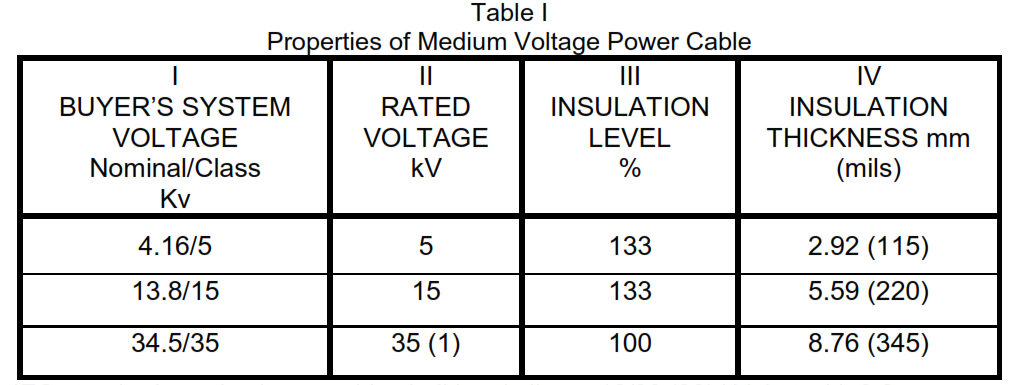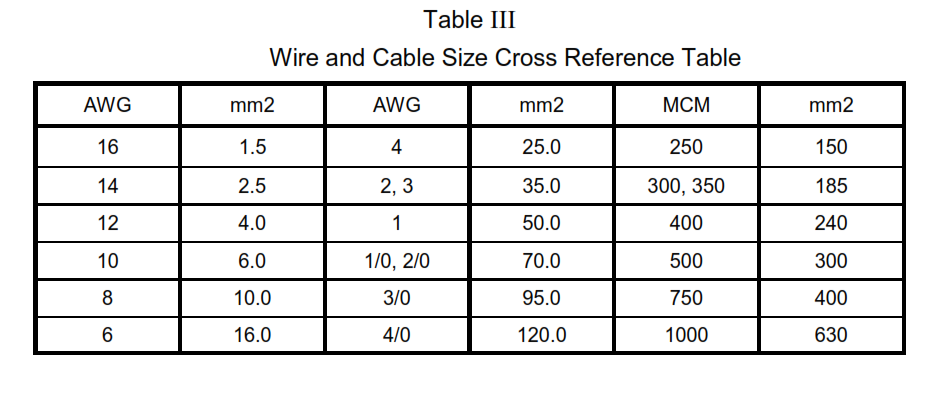This article is for manufacturing, testing of 5 to 35 kV power cables. Main keywords for this article are Medium Voltage Power Cable IEC 60502, Cables 5 to 35 kV Design Requirement NEC and IEC, Medium Voltage Power Cable AEIC CS8, Medium Voltage Cable Standards.
Cables 5 to 35 kV Design Requirement NEC and IEC
References
American Society for Testing and Materials (ASTM)
B 3 Specification for Soft or Annealed Copper Wire
B 8 Specification for Concentric-Lay-Stranded Copper Conductors, Hard, Medium-Hard, or Soft
Association of Edison Illuminating Companies (AEIC)
CS8 Specification For Extruded Dielectric Sheilded Power Cables Rated 5 Through 46 kV
Institute of Electrical and Electronic Engineers (IEEE)
383 Type Test of Class 1E Electric Cables
1202 Flame Testing of Cables for Use In Cable Trays
Insulated Cable Engineers Association / National Electric Manufacturers Association (ICEA/NEMA)
ICEA S-93-639 /NEMA WC74 5-46 kV Shielded Power Cable For use in The Transmission And Distribution Of Electric Energy
International Electrotechnical Commission (IEC)
60038 IEC Standard Voltages
60228 Conductors of Insulated Cables
60332-3 (series) Tests on Electric and optical fibre Cables under Fire Conditions:
Test for vertical flame spread of vertically-mounted bunched wires or cables
60502 Extruded Solid Dielectric Insulated Power Cables for Rated Voltages from 1 kV up to 30 kV
National Fire Protection Association (NFPA)
70 National Electrical Code (NEC),
Underwriters Laboratories, Inc. (UL)
1072 Medium-Voltage Power Cables
Medium Voltage Power Cable – IEC 60502
- Cable shall be manufactured in accordance with IEC 60502.
- The individual wire and cable conductors shall be insulated with ethylene propylene rubber (EPR) or tree retardant cross-linked polyethylene (XLPE) insulation.
- Thermoplastic insulating compounds are not acceptable.
- Conductors shall be plain annealed stranded copper conductors conforming to IEC 60228 Class 2.
- Conductor and insulation screening shall be required for all cables.
- Conductor strand screen shall be an extruded semiconducting layer compatible with the insulation, and shall have an allowable operating temperature equal to that of the insulation. A non-metallic semiconducting tape shield is not acceptable. The conductor screen shall be easily removable from the conductor without leaving any residue. The conductor screen shall bond to the insulation.
- Non-metallic part of the insulation screen shall consist of an extruded semiconducting layer applied directly over the insulation. Insulation screen shall be easily stripped leaving no residue on the insulation surface. Insulation screen shall bond to the insulation.
- Insulation material shall be crosslinked polyethylene (XLPE) or ethylene propylene rubber (EPR).
Extruded semiconducting conductor shield, the insulation, and the semiconducting insulation shield shall be applied by simultaneous triple extrusion. Steam curing is not acceptable for XLPE insulated cable.
The rated voltage, insulation thickness and field (commissioning) test voltage of the cable shall be in accordance with Table I.

- Metallic part of the insulation screen (shield) shall consist of a nonmagnetic copper tape helically applied separately over each of the semiconductor-shielded, insulated conductors. Copper tape shall be a minimum of 0.125 mm (5 mil) thickness, applied with a minimum of 20 percent overlap. In addition, when XLPE insulation is utilized, a water blocking (swellable) tape with minimum 15 percent overlap shall be helically applied over the metallic shield.
- IEC 60502 Class 2, stranded copper ground conductor shall be provided in the interstices of the cable, if specified in SES E22-X02.
- Cables shall have a flame retardant and termite resistant PVC jacket. The material for the cable jacket shall be extruded directly onto the surface to be covered. Cable jacket shall be continuous, homogeneous, voidless, seamless, and free of foreign material.
- The outer sheath (jacket) shall be sunlight resistant and oil resistant.
- The magnitude of the discharge during the partial discharge test shall not be higher than 5 pC at 1.5 Uo.
- Cable shall meet the flame retardance test specified in IEC 60332-3.
- After installation and before the cables are placed in regular service, they shall be in accordance with dc high potential tests specified in AEIC CS5 or CS6, at test voltage levels established by AEIC CS5 or CS6 and shown in Table I. After the cables have been in service, dc high potential tests shall be required, in accordance with AEIC CS5 or CS6.
Medium Voltage Power Cable – AEIC CS8
- Cable shall be manufactured and tested in accordance with AEIC CS8 and ICEA S93-639 / NEMA WC74.
- Individual wire and cable conductors shall be insulated with ethylene propylene rubber (EPR) or tree retardant cross-linked polyethylene (XLPE) insulation, 133 percent level. Thermoplastic insulating compounds are not acceptable.
- Rated voltage, insulation thickness and field (commissioning) test voltage of the cable shall be in accordance with Table II.
- Conductor material shall be plain annealed copper in accordance with ASTM B 3.
- Conductors shall be concentric lay Class B stranded in accordance with ASTM B 8.
- Conductor and insulation shields shall be required for all cables.
- Conductor strand screen shall be an extruded semiconducting layer compatible with the insulation, and shall have an allowable operating temperature equal to that of the insulation. A non-metallic semiconducting tape shield is not acceptable. The conductor screen shall be easily removable from the conductor without leaving any residue. The conductor screen shall bond to the insulation.
- Non-metallic part of the insulation screen shall consist of an extruded semiconducting layer applied directly over the insulation. The insulation screen shall be easily stripped leaving no residue on the insulation surface. The insulation screen shall bond to the insulation.
- Extruded semiconducting conductor shield, insulation, and semiconducting insulation shield shall be applied by simultaneous triple extrusion. Steam curing is not acceptable for XLPE insulated cable.
- Metallic part of the insulation screen (shield) shall consist of a nonmagnetic copper tape helically applied separately over each of the semiconductor-shielded, insulated conductors. Copper tape shall be a minimum of 0.125 mm (5 mil) thickness, applied with a minimum of 20 percent overlap. In addition, when XLPE insulation is utilized, a water blocking (swellable) tape with minimum 15 percent overlap shall be helically
applied over the metallic shield. - ASTM B 8 Class B stranded copper ground conductor shall be provided in the interstices of the cable.
- Cables shall have a flame retardant and termite resistant PVC jacket. The material for the cable jacket shall be extruded directly onto the surface to be covered. The cable jacket shall be continuous, homogeneous, voidless, seamless, and free of foreign material.
- Outer jacket shall conform to sunlight resistance and the oil resistance I or II requirements of UL 1072.
- Partial discharge testing shall be in accordance with AEIC CS8.
- Cable shall conform to vertical tray flame test specified in UL 1072.
- Cables shall be suitable for one or more of direct burial, duct banks or cable trays, as specified in the purchase order. See SES E22-C01 for specific requirements on cable
applications and installations. - After installation and before the cables are placed in regular service, they shall be capable of meeting the dc high potential tests specified in AEIC CS8, at test voltage levels established by AEIC CS8 and shown in Table F-1. Additionally, after the cables have been in service, dc high potential tests shall be required, in accordance with AEIC CS8.
Number and Size of Conductors
- The minimum conductor size for each voltage level is 6 AWG for 5 kV, 2 AWG for 15 kV and 1/0 AWG for 35 kV. See Table III for US to metric cross reference.
- The minimum size for grounding conductors is shown in Table IV.
Ampacity
The base current carrying capacity of cables shall be in accordance with NFPA 70, 1999 Edition, Tables 310-67 to 310-86. Company will reduce the ampacity in accordance with the appropriate requirements of the NEC, based on installation method and site conditions.
Single Conductor Cables
- Single conductor unarmored cable shall have a PVC jacket consisting of an extruded layer of PVC compound applied over the water blocking tape (when provided), or over the insulation shield when a water blocking tape is not provided. The PVC jacket shall be suitable for the operating temperature of the cable and shall be flame retardant and termite resistant. Cables shall have suitable flexibility for the method of installation and shall be resistant to moisture and exposure to ultraviolet (UV) light.
- Single conductor armored cable shall have an extruded layer of polyethylene (PE) bedding applied over the water blocking tape (when provided) or over the insulation shield when a water blocking tape is not provided. An armor consisting of a layer of round aluminum wires shall be applied concentrically over the PE bedding. An overall PVC jacket consisting of an extruded layer of PVC compound shall be applied over the PE bedding. PVC jacket shall be suitable for the operating temperature of the cable and shall be flame retardant and termite resistant. Cables shall have suitable flexibility for the method of installation and shall be resistant to moisture and exposure to ultraviolet (UV) light. PVC jacket shall conform to the minimum thickness requirements of Table V.
Multiconductor Cables
Multiconductor cables shall be suitable for installation in cable trays or cable trenches for direct burial applications. Multiconductor cables shall be three (3) conductors each with a continuous copper tape shield and separate grounding conductor(s).
Non-armored Cables
Insulated conductors of the multiconductor cable shall be assembled with grounding conductor(s) and non-hygroscopic polypropylene fillers in the interstices. The assembly shall be bound with a binder tape of polyester or other suitable material. An inner water blocking (swellable) tape shall be helically applied over the assembly, when the insulation is XLPE. PVC outer jacket shall be extruded over the water blocking tape
(when provided) or over the bound assembly when a water blocking tape is not provided.
Armored Cables
- Insulated conductors and grounding conductors shall be assembled as described in 10.1. An extruded layer of PE bedding with minimum thickness of 1.27 mm (50 mils) shall be applied over the water blocking tape (when
provided), or over the bound assembly when a water blocking tape is not provided. The armor shall then be applied concentrically over the PE bedding. If a layer of round wire armor is used, a galvanized steel tape may be applied over the wire armor as a binder, in open helix. - An overall PVC jacket shall be provided. The jacket shall consist of an extruded layer of PVC compound suitable for the operating temperature of the cable. The jacket shall meet the minimum thickness requirements of Table VI and shall be labeled UV resistant.
Testing and Inspection
The following routine tests shall be performed:
a. DC conductor resistance test
b. Partial discharge test
c. Insulation resistance (Hi Pot) test
Main keywords for this article are Medium Voltage Power Cable IEC 60502, Cables 5 to 35 kV Design Requirement NEC and IEC, Medium Voltage Power Cable AEIC CS8, Medium Voltage Cable Standards.




